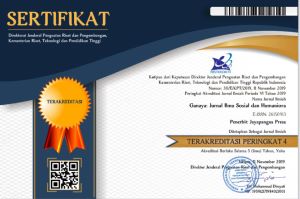Analisis Mobilitas Mayarakat Nomaden di Kepulauan Riau: Studi Orang Suku Laut Desa Berakit Kabupaten Bintan
DOI:
https://doi.org/10.37329/ganaya.v6i4.2685Keywords:
Mobilitas, Suku Laut, Masyarakat NomadenAbstract
The sea tribe people are one of the unique community groups that can be found in the Riau Islands. Currently, there are several sea tribe community groups that have begun to be placed in residential areas in regions in the Riau Islands. The uniqueness of the culture, traditions and lifestyle of the Sea Tribe people should be something that can be passed on to their future generations. As the lifestyle of the sea tribe people in Berakit Village has shifted to settling on land, their traditions, culture and customs are slowly disappearing. One of the distinctive features of the Sea Tribe people is wandering on a raft combing the islands along the Riau Islands coast. This study aims to highlight the mobility pattern of the Sea Tribe people in Berakit Village, Bintan Regency. Hence, this study was conducted on the sea tribe people to identify the mobility patterns that occur in Berakit Village, Bintan Regency. The purpose of this study is to understand the mobility pattern of the sea tribe in Berakit Village and the factors that influence it. The study method uses Qualitative Type. The results of the study indicate that the mobility pattern of the sea tribe in Berakit Village is influenced by various factors such as economy, social, politics, psychology, and place utility which means living on a raft on the sea has spiritual functions and values for them. This study also shows that the sea tribe's mobility is not entirely influenced by pressure or needs, but more on their cultural values and traditions. The study recommends that the local government needs to empower the sea tribe in cultural preservation and improving their quality of life. However, this intervention should be done by respecting and considering the cultural values of the sea tribe.
References
Amalia, R. D. (2018). Orang Suku Laut dan ekonomi penghidupan berbasis laut di Kabupaten Sampang. Jurnal Pemerintahan dan Kebijakan Publik, 10(1), 41-57.
Azwar, A. (2017). Pendidikan dan pengetahuan orang Suku Laut tentang lingkungan alam dan kecenderungan modifikasi ekosistem. Jurnal Ilmu Lingkungan, 15(2), 153-162.
Chou, C. (1994). Money, magic and fear: identity and exchange amongst the Orang Suku Laut (sea nomads) and other groups of Riau and Batam, Indonesia. In Doctoral dissertation, University of Cambridge.
Chou, C. (2003). Indonesian Sea Nomads: Money, Magic, and Fear of the Orang Suku Laut. Routledge Curzon.
Chou, C. (2006). Borders and Multiple Realities: The Orang Suku Laut of Riau, Indonesia. In Centering the Margin (pp. 111–134). Berghahn Books.
Chou, C. (2016). The Water World of the Orang Suku Laut in Southeast Asia. TRaNS: Trans-Regional and -National Studies of Southeast Asia, 4(2), 265–282.
Chou, C. (2020). On Being Orang Suku Laut in the Malay World. In Nomad-State Relationships in International Relations: Before and After Borders (pp. 217–237). Springer International Publishing.
Dingle, H., & Alistair Drake, V. (2007). What Is Migration? BioScience, 57(2), 113–121.
Hidayat, A. A. (2021). Identitas orang Suku Laut di perairan Pulau Rupat. Jurnal Sosial dan Politik, 11(1), 61-73.
Kaartinen, T. (2011). The Orang Suku Laut of Rian, Indonesia: The Inalienable Gift of Territory. 2(April).
Kusuma, P., Brucato, N., Cox, M. P., Letellier, T., Manan, A., Nuraini, C., Grangé, P., Sudoyo, H., & Ricaut, F.-X. (2017). The last sea nomads of the Indonesian archipelago: genomic origins and dispersal. European Journal of Human Genetics 2017 25:8, 25(8), 1004–1010.
L. Lenhart. (1997). Orang Suku Laut Ethnicity and Acculturation. 153, 577–604.
Lenhart, L. (1997). Orang Suku Laut Ethnicity and Acculturation. In Bijdragen tot de Taal. Land-en Volkenkunde.
Rajaram, P. K., & Grundy-Warr, C. (2004). The Irregular Migrant as Homo Sacer: Migration and Detention in Australia, Malaysia, and Thailand. International Migration, 42(1), 33–64.
Saepulloh, R. (2021). Pekerja Migran Indonesia Sumbang Devisa Rp159 Triliun. Warta Ekonomi. https://wartaekonomi.co.id/read335908/pekerja-migran-indonesia-sumbang-devisa-rp159-triliun?page=2
Wijayanti, A., & Nurhakim, S. (2017). Karakteristik sosial ekonomi dan keberlanjutan nelayan Suku Laut di Taman Nasional Wakatobi. Jurnal Manusia dan Lingkungan, 24(2), 123-130
Downloads
Published
How to Cite
Issue
Section
License
Copyright (c) 2023 Suryaningsih Suryaningsih, Tri Samnuzulsari, Siti Arieta, Tety Kurmalasari (Author)

This work is licensed under a Creative Commons Attribution-ShareAlike 4.0 International License.
An author who publishes in the Ganaya : Jurnal Ilmu Sosial dan Humaniora agrees to the following terms:
- Author retains the copyright and grants the journal the right of first publication of the work simultaneously licensed under the Creative Commons Attribution-ShareAlike 4.0 License that allows others to share the work with an acknowledgement of the work's authorship and initial publication in this journal
- Author is able to enter into separate, additional contractual arrangements for the non-exclusive distribution of the journal's published version of the work (e.g., post it to an institutional repository or publish it in a book) with the acknowledgement of its initial publication in this journal.
- Author is permitted and encouraged to post his/her work online (e.g., in institutional repositories or on their website) prior to and during the submission process, as it can lead to productive exchanges, as well as earlier and greater citation of the published work (See The Effect of Open Access).
Read more about the Creative Commons Attribution-ShareAlike 4.0 Licence here: https://creativecommons.org/licenses/by-sa/4.0/.








